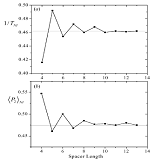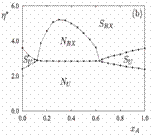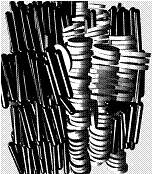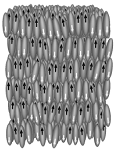A. G. Vanakaras, Langmuir, 22, 88-93 (2006).
 Abstract: The phase behavior and associated pattern formation of two-dimensional systems of hard disks decorated with amphiphilic coronae (Janus disks) are studied by means of Monte Carlo computer simulations. A primitive interaction potential that captures the essential interparticle interactions is introduced. Despite its simplicity, the system exhibits a very rich phase polymorphism. Apart from the isotropic phase and depending upon the coronal thickness, the simulated systems self-organize in a number of two-dimensional mesophases of various symmetries exhibiting a variety of novel patterns. The results of these simulations suggest that 2D Janus particles are promising candidates for bottom-up design of precise two-dimensional templates.
Abstract: The phase behavior and associated pattern formation of two-dimensional systems of hard disks decorated with amphiphilic coronae (Janus disks) are studied by means of Monte Carlo computer simulations. A primitive interaction potential that captures the essential interparticle interactions is introduced. Despite its simplicity, the system exhibits a very rich phase polymorphism. Apart from the isotropic phase and depending upon the coronal thickness, the simulated systems self-organize in a number of two-dimensional mesophases of various symmetries exhibiting a variety of novel patterns. The results of these simulations suggest that 2D Janus particles are promising candidates for bottom-up design of precise two-dimensional templates.
S.D. Peroukidis, A.G. Vanakaras and D.J. Photinos, J. Chem. Phys., 123, 164904 (2005).
(Selected for the November 7, 2005 issue of Virtual Journal of Nanoscale Science & Technology.)
Abstract: Systematic efforts to synthesize fullerene-containing liquid crystals have produced a variety of successful model compounds. We present a simple molecular theory, based on the interconverting shape approach [Vanakaras and Photinos, J. Mater. Chem. 15, 2002 (2005)], that relates the self-organization observed in these systems to their molecular structure. The interactions are modeled by dividing each molecule into a number of submolecular blocks to which specific interactions are assigned. Three types of blocks are introduced, corresponding to fullerene units, mesogenic units, and nonmesogenic linkage units. The blocks are constrained to move on a cubic three-dimensional lattice and molecular flexibility is allowed by retaining a number of representative conformations within the block representation of the molecule. Calculations are presented for a variety of molecular architectures including twin mesogenic branch monoadducts of C-60, twin dendromesogenic branch monoadducts, and conical (badminton shuttlecock) multiadducts of C-60. The dependence of the phase diagrams on the interaction parameters is explored. In spite of its many simplifications and the minimal molecular modeling used (three types of chemically distinct submolecular blocks with only repulsive interactions), the theory accounts remarkably well for the phase behavior of these systems.
On the molecular theory of dimer liquid crystals
P.K. Karahaliou, A.G. Vanakaras and D.J. Photinos, Liq. Cryst., 32, 1397-1407 (2005).
 Abstract: We present a statistical mechanics approximation scheme for the explicit treatment of spacer-mediated configurational correlations among the mesogenic units that form a dimer molecule. The approximation is applied to the description of the nematic phase of linear uniaxial dimers interacting via a standard molecular pair-potential. Transition temperatures, order parameters and pair correlation averages are calculated for different spacer lengths. The results readily reproduce the experimentally observed trends of phase transition thermodynamics and of dipolar correlations deduced from dielectric studies.
Abstract: We present a statistical mechanics approximation scheme for the explicit treatment of spacer-mediated configurational correlations among the mesogenic units that form a dimer molecule. The approximation is applied to the description of the nematic phase of linear uniaxial dimers interacting via a standard molecular pair-potential. Transition temperatures, order parameters and pair correlation averages are calculated for different spacer lengths. The results readily reproduce the experimentally observed trends of phase transition thermodynamics and of dipolar correlations deduced from dielectric studies.
A.G. Vanakaras and D.J. Photinos, J. Mater. Chem. 15, 2002-2012 (2005).
Abstract: We present tractable molecular theory descriptions of liquid crystalline dendrimers based on clearly defined approximations and in terms of the dominant interactions underlying the self-organisation of these large and complex supermolecular entities. We formulate the configurational partition function for dendrimers, taking explicit account of their conformations and segmental interactions. Two approximate schemes are presented: the first is based on the effective interactions of the dendrimers as a whole while the second scheme is based on the interactions among the mesogenic units contained in the dendrimers. Results of lattice calculations for phase transitions in the context of the first scheme are presented and they show that the minimal inclusion of shape anisotropy and of sub-molecular partitioning into chemically distinct parts is sufficient to reproduce the variety of phases and phase sequences observed experimentally and provides insights into the conformational aspect of these transitions. In the second scheme, the description of the dendromesogenic system reduces to that of an ensemble of mesogenic dimers. This scheme can be readily extended to the description liquid crystalline oligomers and polymers consisting of mesogenic units connected by flexible spacers in various architectures. It thus provides a unified approach for treating mesomorphic phase transitions of supermolecular and macromolecular systems that can be built by connecting the same submolecular units in topologically different ways.
Structure and Nanomechanics of Linear Dendronised Polymers: A Molecular Simulation Study, D. K. Christopoulos, D. J. Photinos, L. M. Stimson, A. F. Terzis and A. G. Vanakaras, J. Mater. Chem. 13, 2756-2764 (2003).
Abstract: We use Monte Carlo algorithms to simulate, on the atomistic scale, the structure and rigidity of model linear dendronised polymers (LDPs) consisting of a poly(para-phenylene) backbone with laterally substituted Frechet type dendritic units. A coarse-grained representation of united atoms interacting via steric repulsions is employed for the study of the equilibrium structure of single LDPs as a function of dendron generation, g. Backbone conformation averages and dendron mass distributions are calculated for g = 0 to 5 and are used to elucidate the mechanism of stiffening of the LDP with increasing g. Congestion-induced stiffening, reflecting on the response of the backbone to linear extension as well as to bend and torsion deformations, is clearly detected for g = 4 and is dramatically intensified at g = 5 where, in addition, strongly bent and twisted structures develop along the backbone contour and reduce appreciably the equilibrium elongation of the LDP.
A. G. Vanakaras and D. J. Photinos, Mol. Cryst. Liq. Cryst., 315, 213 (2003).
 Abstract: Various possibilities of polar self-organisation in low molar mass nematic, smectic and columnar liquid crystals are discussed with particular focus on the underlying molecular symmetries and interactions. Distinction is made between vector and pseudovector polarities, their quantification in terms of molecular order parameters and their relation to spontaneous electric polarisation and to molecular chirality. The understanding of the molecular mechanisms that give rise to polar ordering in existing lamellar and columnar phases may be useful for the design of new polar variants of common a-polar liquid crystals.
Abstract: Various possibilities of polar self-organisation in low molar mass nematic, smectic and columnar liquid crystals are discussed with particular focus on the underlying molecular symmetries and interactions. Distinction is made between vector and pseudovector polarities, their quantification in terms of molecular order parameters and their relation to spontaneous electric polarisation and to molecular chirality. The understanding of the molecular mechanisms that give rise to polar ordering in existing lamellar and columnar phases may be useful for the design of new polar variants of common a-polar liquid crystals.
A. G. Vanakaras, M. A. Bates and D. J. Photinos, Phys. Chem. Chem. Phys. 5(17), 3700 (2003).
 Abstract: Variational cluster calculations and Monte Carlo simulations are applied to hard-body board-like models of biaxial molecules forming liquid crystalline phases. The molecular long axes are assumed for simplicity to be fully oriented. Depending on the extent of transverse anisometry in the molecular shape, these systems can exhibit biaxial nematic phases as well as uniaxial and biaxial orthogonal smectic phases. It is shown that the region of thermodynamic stability for the biaxial nematic phase is considerably broadened in binary mixtures of molecules with the same cross section but differing in their long dimension.
Abstract: Variational cluster calculations and Monte Carlo simulations are applied to hard-body board-like models of biaxial molecules forming liquid crystalline phases. The molecular long axes are assumed for simplicity to be fully oriented. Depending on the extent of transverse anisometry in the molecular shape, these systems can exhibit biaxial nematic phases as well as uniaxial and biaxial orthogonal smectic phases. It is shown that the region of thermodynamic stability for the biaxial nematic phase is considerably broadened in binary mixtures of molecules with the same cross section but differing in their long dimension.
A. Galindo, A. J. Haslam, S. Varga, G. Jackson, A. G. Vanakaras, D. J. Photinos and D. A. Dunmur, J. Chem. Phys. 119(10), 5216 (2003).
 Abstract: The phase behavior of a binary mixture of rodlike and disclike hard molecules is studied using Monte Carlo NVT computer simulation. The rods are modeled as hard spherocylinders of aspect ratio L-HSC/D-HSC=5, and the discs as hard cut spheres of aspect ratio L-CS/D-CS=0.12. The diameter ratio D-CS/D-HSC=3.62 is chosen such that the molecular volumes of the two particles are equal. The starting configuration in the simulations is a mixed isotropic state. The phase diagram is mapped by changing the overall density of the system. At low densities stabilization of the isotropic phase relative to the ordered states is seen on mixing, and at high densities nematic-columnar and smectic A-columnar phase coexistence is observed. Biaxiality in the nematic phase is not seen. The phase diagram of the mixture is also calculated using the second virial theory of Onsager for nematic ordering, together with the scaling of Parsons and Lee to take into account the higher virial coefficients. The disc-disc and rod-disc excluded volumes are evaluated numerically using the exact overlap expressions, and the lower-order end-effects are incorporated. The exact rod-rod excluded volume is known analytically. In the case of the theoretical calculations, which are limited to translationally disordered phases, coexistence between two uniaxial nematic phases is predicted, as well as the stabilization of the disc-rich isotropic phases. As found in the simulation, biaxial nematic phases are not predicted to be stable. The phase equilibria of an experimental system is also reported which exhibits a behavior close to the system studied by computer simulation. As in the model mixtures, this system exhibits a marked destabilization of the ordered phases on mixing, while nematic-columnar demixing is observed at lower temperatures (the higher-density states).
Abstract: The phase behavior of a binary mixture of rodlike and disclike hard molecules is studied using Monte Carlo NVT computer simulation. The rods are modeled as hard spherocylinders of aspect ratio L-HSC/D-HSC=5, and the discs as hard cut spheres of aspect ratio L-CS/D-CS=0.12. The diameter ratio D-CS/D-HSC=3.62 is chosen such that the molecular volumes of the two particles are equal. The starting configuration in the simulations is a mixed isotropic state. The phase diagram is mapped by changing the overall density of the system. At low densities stabilization of the isotropic phase relative to the ordered states is seen on mixing, and at high densities nematic-columnar and smectic A-columnar phase coexistence is observed. Biaxiality in the nematic phase is not seen. The phase diagram of the mixture is also calculated using the second virial theory of Onsager for nematic ordering, together with the scaling of Parsons and Lee to take into account the higher virial coefficients. The disc-disc and rod-disc excluded volumes are evaluated numerically using the exact overlap expressions, and the lower-order end-effects are incorporated. The exact rod-rod excluded volume is known analytically. In the case of the theoretical calculations, which are limited to translationally disordered phases, coexistence between two uniaxial nematic phases is predicted, as well as the stabilization of the disc-rich isotropic phases. As found in the simulation, biaxial nematic phases are not predicted to be stable. The phase equilibria of an experimental system is also reported which exhibits a behavior close to the system studied by computer simulation. As in the model mixtures, this system exhibits a marked destabilization of the ordered phases on mixing, while nematic-columnar demixing is observed at lower temperatures (the higher-density states).
R. Berardi, S. Orlandi, D. J. Photinos, A. G. Vanakaras and C. Zannoni, Phys. Chem. Chem. Phys. 4(5), 770 (2002).
 Abstract: We study the effect of molecular dipole strength on the polymorphism of smectic A liquid crystals using computer simulations and density functional theory. We find, for a system of polar Gay-Berne particles with an off-centre axial dipole, a change in molecular organisation from non-interdigitated to interdigitated (S-Ad) structure.
Abstract: We study the effect of molecular dipole strength on the polymorphism of smectic A liquid crystals using computer simulations and density functional theory. We find, for a system of polar Gay-Berne particles with an off-centre axial dipole, a change in molecular organisation from non-interdigitated to interdigitated (S-Ad) structure.
P. K. Karahaliou, A. G. Vanakaras and D. J. Photinos, Phys. Rev. E, 65, 031712 (2002).
 Abstract: The order parameters for the phenomenological description of the smectic-A to smectic-C phase transition are formulated on the basis of molecular symmetry and structure. It is shown that, unless the long molecular axis is an axis of twofold or higher rotational symmetry, the ordering of the molecules in the smectic-C phase gives rise to more than one tilt order parameter and to one or more polar order parameters. The latter describe the indigenous polarity of the smectic-C phase, which is not related to molecular chirality but underlies the appearance of spontaneous polarization in chiral smectics. A phenomenological theory of the phase transition is formulated by means of a Landau expansion in two tilt order parameters (primary and secondary) and an indigenous polarity order parameter. The coupling among these order parameters determines the possibility of sign inversions in the temperature dependence of the spontaneous polarization and of the helical pitch observed experimentally for some chiral smectic-C* materials. The molecular interpretation of the inversion phenomena is examined in the light of this formulation.
Abstract: The order parameters for the phenomenological description of the smectic-A to smectic-C phase transition are formulated on the basis of molecular symmetry and structure. It is shown that, unless the long molecular axis is an axis of twofold or higher rotational symmetry, the ordering of the molecules in the smectic-C phase gives rise to more than one tilt order parameter and to one or more polar order parameters. The latter describe the indigenous polarity of the smectic-C phase, which is not related to molecular chirality but underlies the appearance of spontaneous polarization in chiral smectics. A phenomenological theory of the phase transition is formulated by means of a Landau expansion in two tilt order parameters (primary and secondary) and an indigenous polarity order parameter. The coupling among these order parameters determines the possibility of sign inversions in the temperature dependence of the spontaneous polarization and of the helical pitch observed experimentally for some chiral smectic-C* materials. The molecular interpretation of the inversion phenomena is examined in the light of this formulation.
 Abstract: The phase behavior and associated pattern formation of two-dimensional systems of hard disks decorated with amphiphilic coronae (Janus disks) are studied by means of Monte Carlo computer simulations. A primitive interaction potential that captures the essential interparticle interactions is introduced. Despite its simplicity, the system exhibits a very rich phase polymorphism. Apart from the isotropic phase and depending upon the coronal thickness, the simulated systems self-organize in a number of two-dimensional mesophases of various symmetries exhibiting a variety of novel patterns. The results of these simulations suggest that 2D Janus particles are promising candidates for bottom-up design of precise two-dimensional templates.
Abstract: The phase behavior and associated pattern formation of two-dimensional systems of hard disks decorated with amphiphilic coronae (Janus disks) are studied by means of Monte Carlo computer simulations. A primitive interaction potential that captures the essential interparticle interactions is introduced. Despite its simplicity, the system exhibits a very rich phase polymorphism. Apart from the isotropic phase and depending upon the coronal thickness, the simulated systems self-organize in a number of two-dimensional mesophases of various symmetries exhibiting a variety of novel patterns. The results of these simulations suggest that 2D Janus particles are promising candidates for bottom-up design of precise two-dimensional templates.




